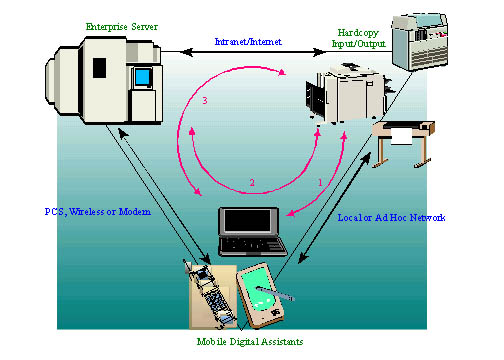The Mobile Triangle, depicted below, defines the pathways
by which a mobile worker can stay connected, maintain his/her information base,
and merge the information highway with the paper trail. It provides a mechanism
to meet the mobile workerís requirement to create hardcopy from his/her mobile
information base.
 |
The corners of the triangle represent points of
information access or storage:
The sides of the triangle represent communication paths between and among devices and information content:
Clearly, the Local or Ad Hoc Network leg of the triangle provides a path for the mobile worker to print information contained on the mobile device (depicted as path 1 in the figure). The more difficult, yet necessary cases involve a two-legged transaction.
In all cases depicted by the Mobile Triangle, service discovery plays a key
factor in every transaction.
The mobile device uses service discovery to locate a
printing device meeting the printing needs. Again using service discovery, the
device driver is located and loaded for the selected printing device. Printing
commences.
Once again, service discovery is used to select a device
and locate its device driver. However,
if the Local or Ad Hoc protocol does not use the same service discovery protocol
as the PCS, Wireless or Modem protocol, an incompatibility may exist, preventing
the necessary discovery.
Service discovery is only used between the Enterprise Server and the hard copy device. Here service discovery is NOT used to locate the device, as the mobile worker has provided the URL. However, service discovery is still needed to determine the capabilities of the selected hardcopy device, then locate and load its device driver. If the hardcopy device is required to support a specific service discovery protocol for the Intranet/Internet leg (e.g., SLP) and a different protocol for the local, Ad Hoc leg (e.g., Bluetooth SDP), the manufacturer of the hardcopy device will face significantly increased implementation costs.
Salutation is best suited to be the service discovery protocol for the Mobile Triangle as it is independent of the operating system and transmission protocol. Therefore, a manufacturer need only support one service discovery technology even if the device supports multiple transmission protocols. Additionally, no service discovery incompatibilities exist if one corner of the triangle is being used as a gateway between two others.